Fin field effect transistor and method of forming the same
Hsu , et al. Nov
U.S. patent number 10,483,397 [Application Number 14/582,576] was granted by the patent office on 2019-11-19 for fin field effect transistor and method of forming the same. This patent grant is currently assigned to TAIWAN SEMICONDUCTOR MANUFACTURING CO., LTD. The grantee listed for this patent is Taiwan Semiconductor Manufacturing Co., Ltd. Invention is credited to Ju-Wang Hsu, Yi-Nien Su, Chih-Yuan Ting, Jang-Shiang Tsai, Tang-Xuan Zhong.
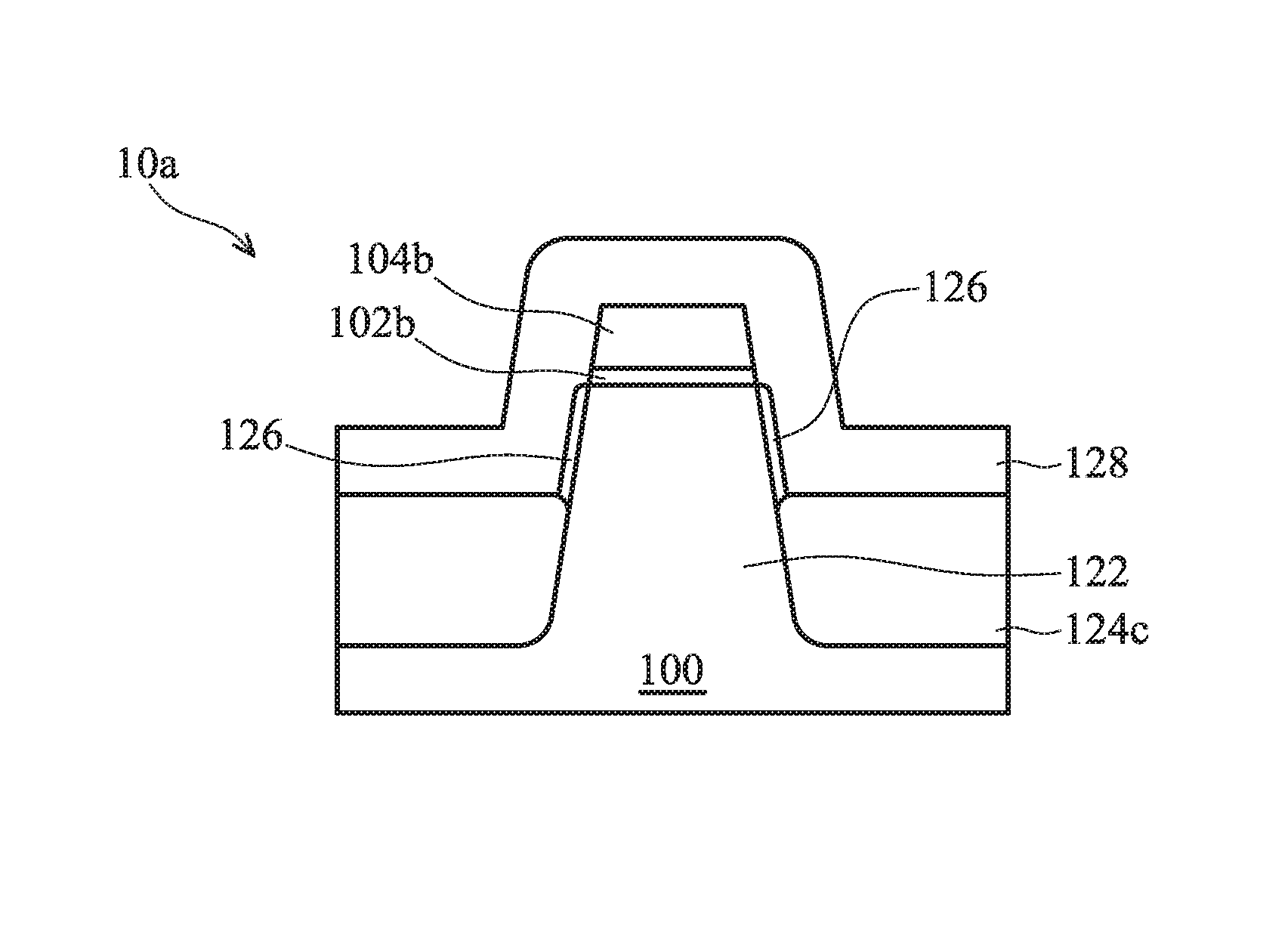
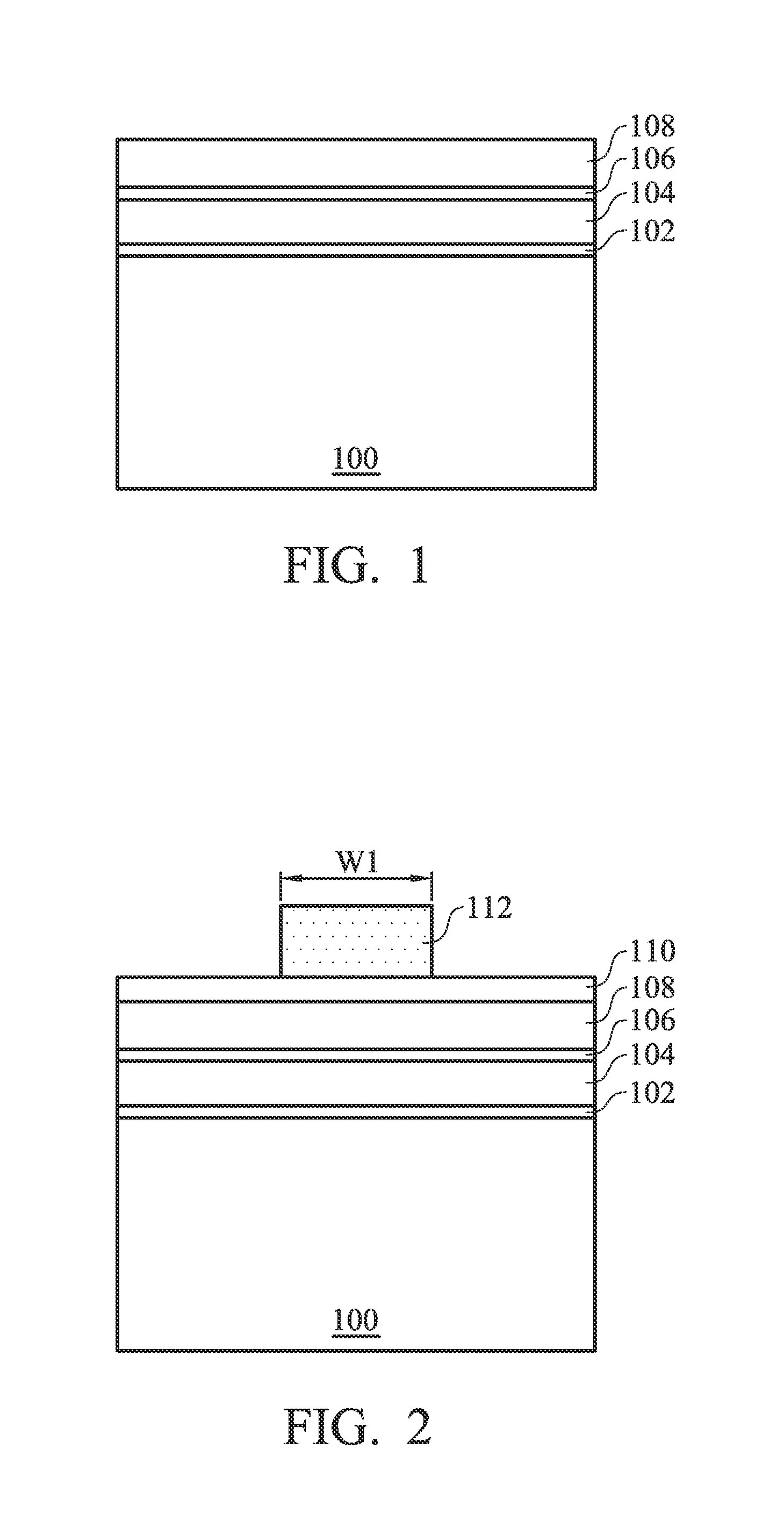
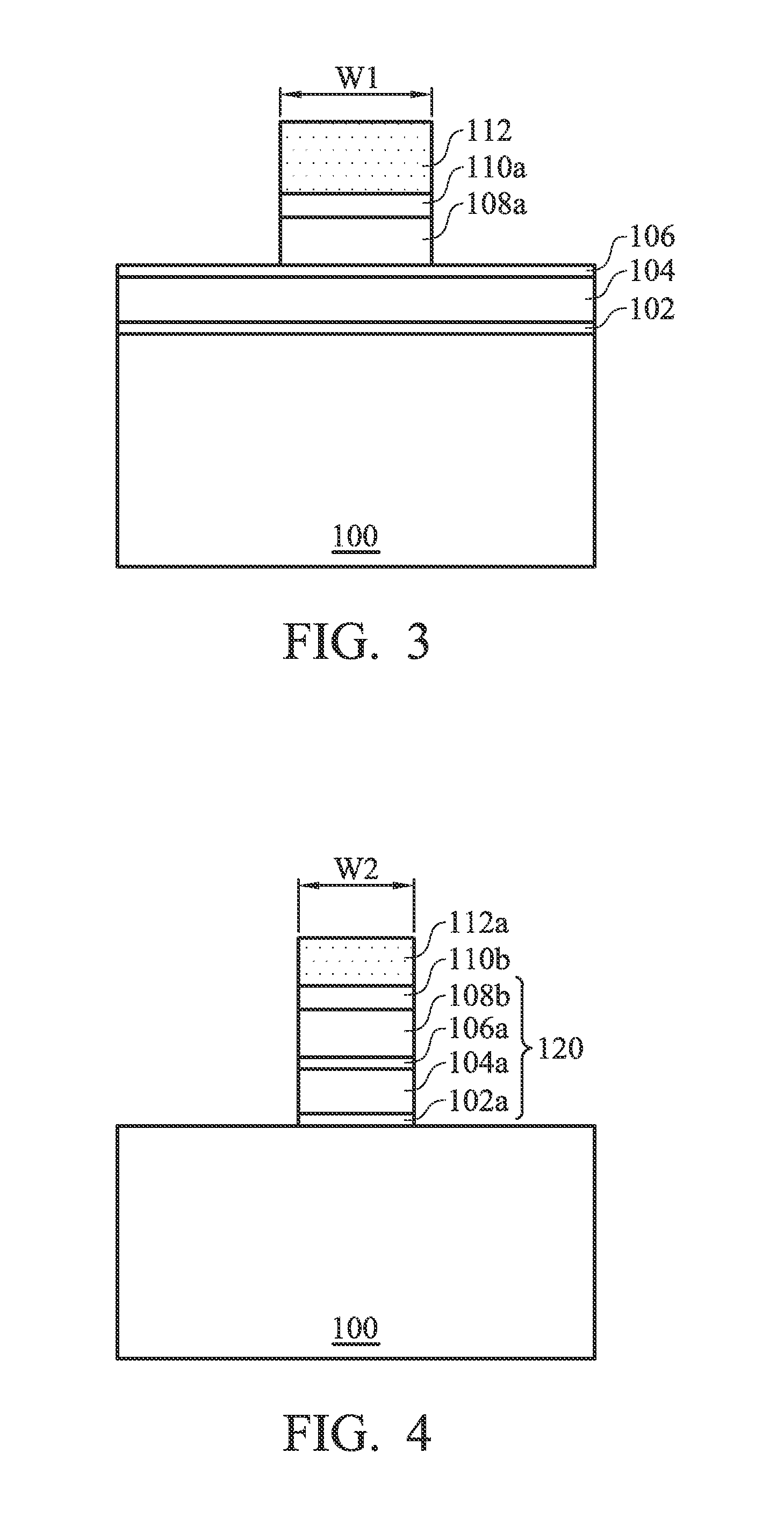

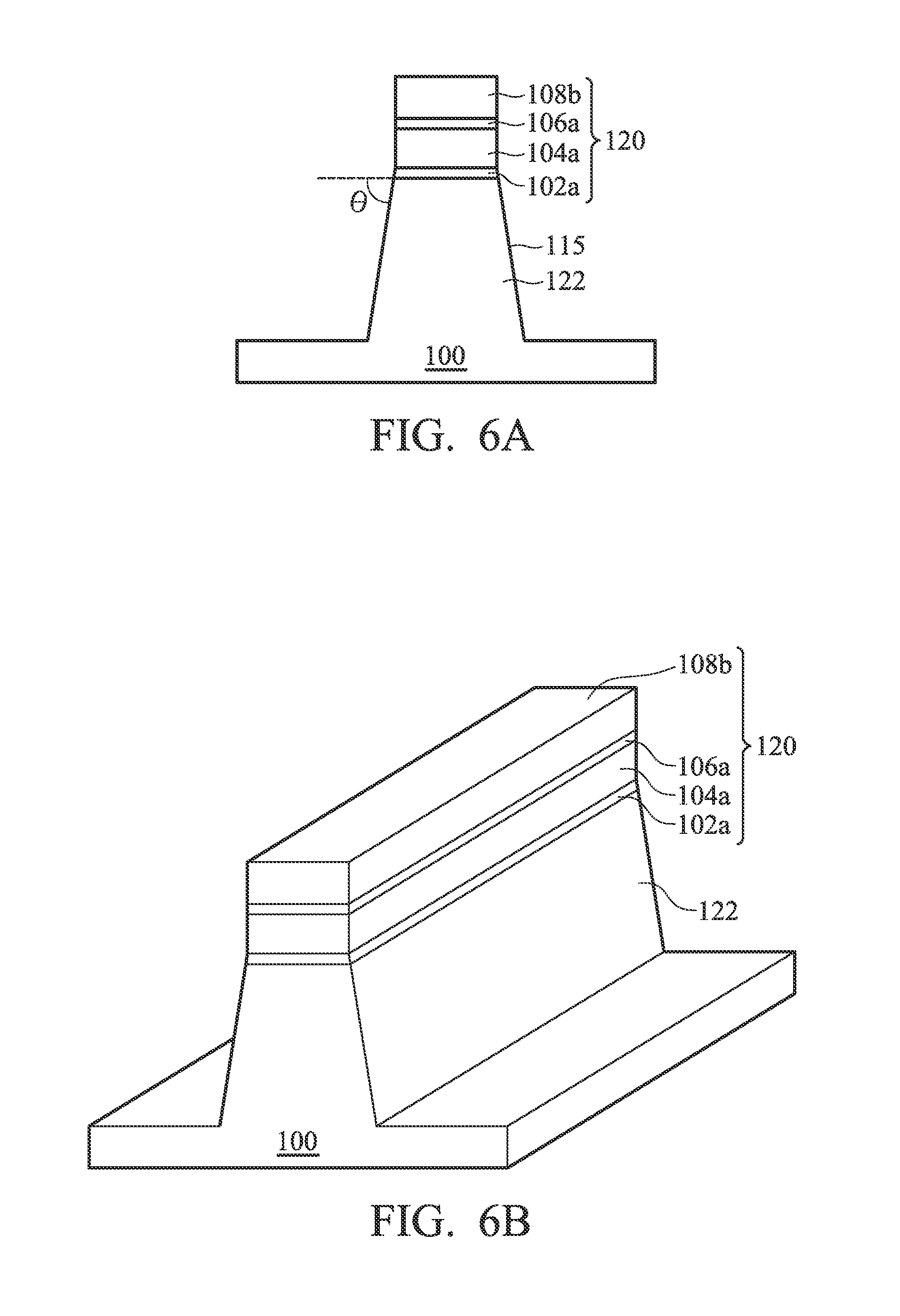
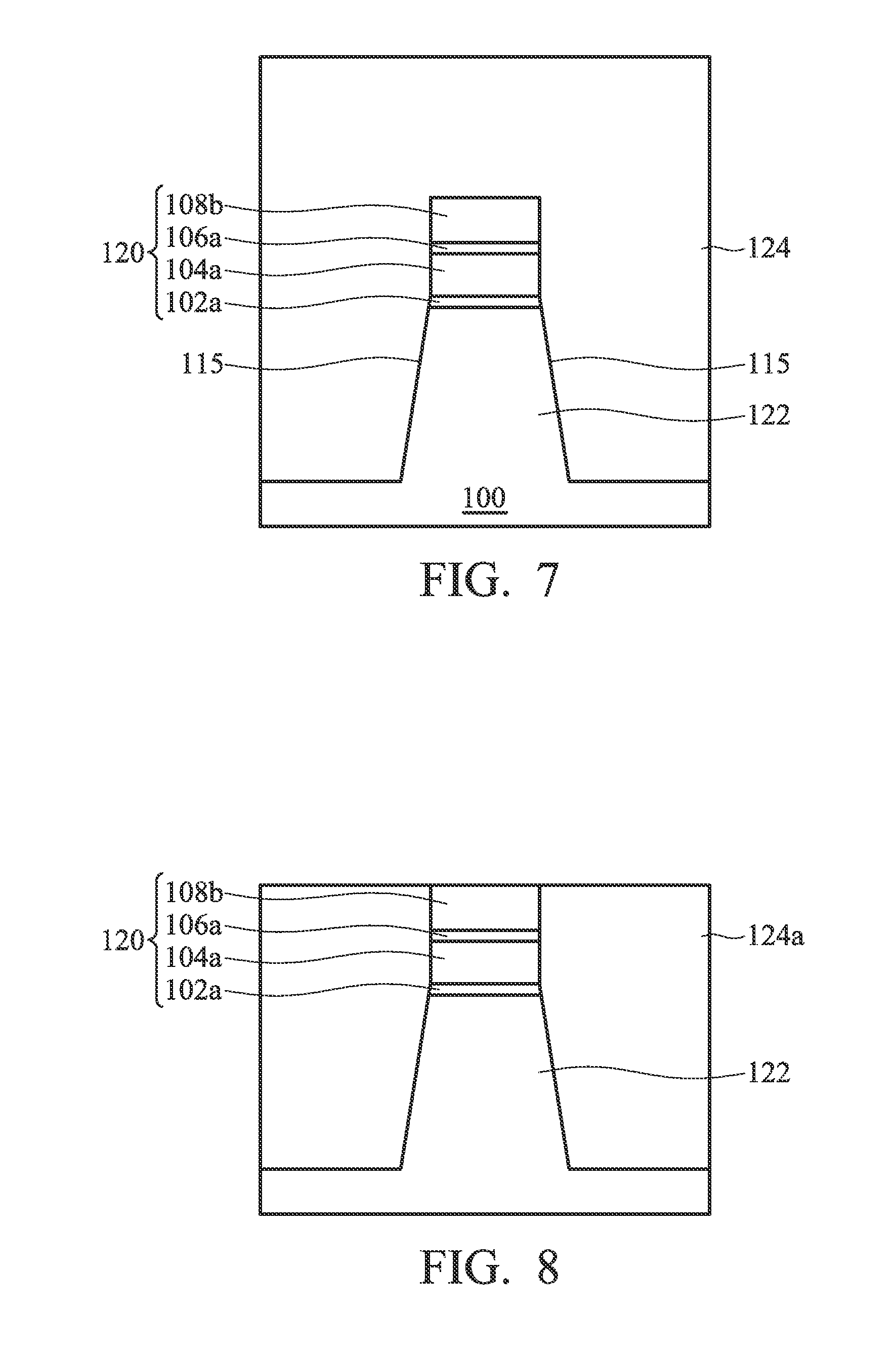
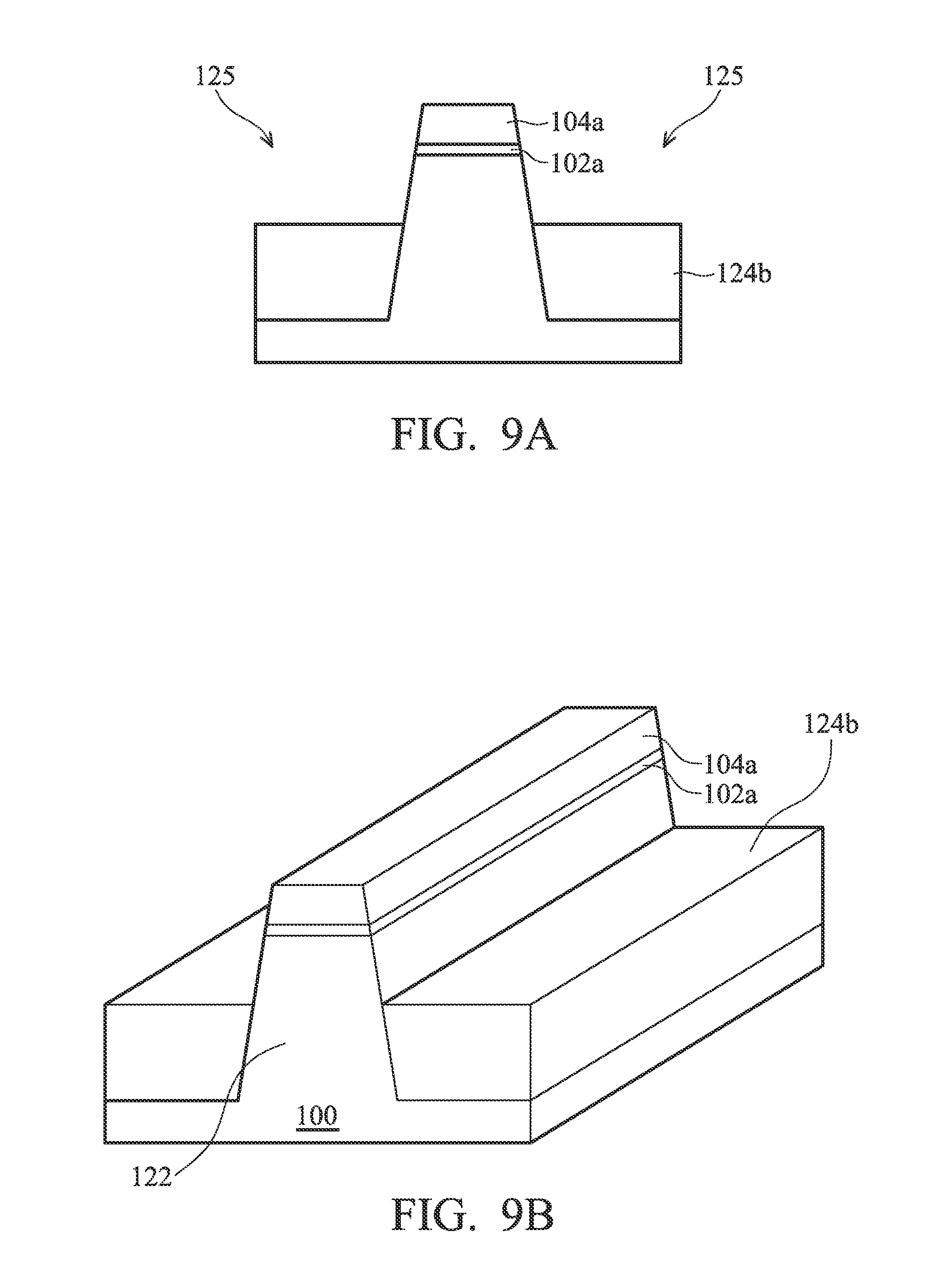
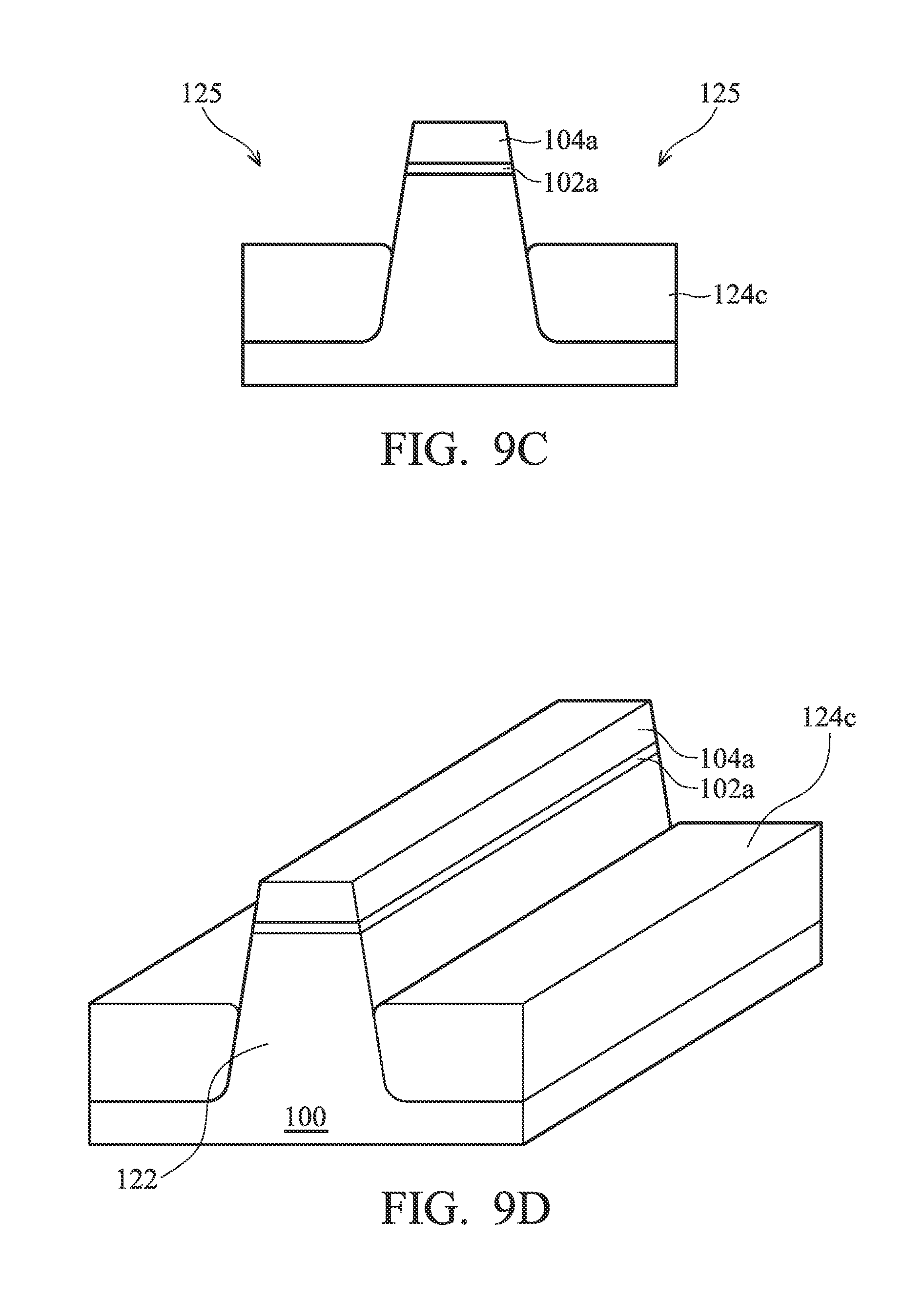
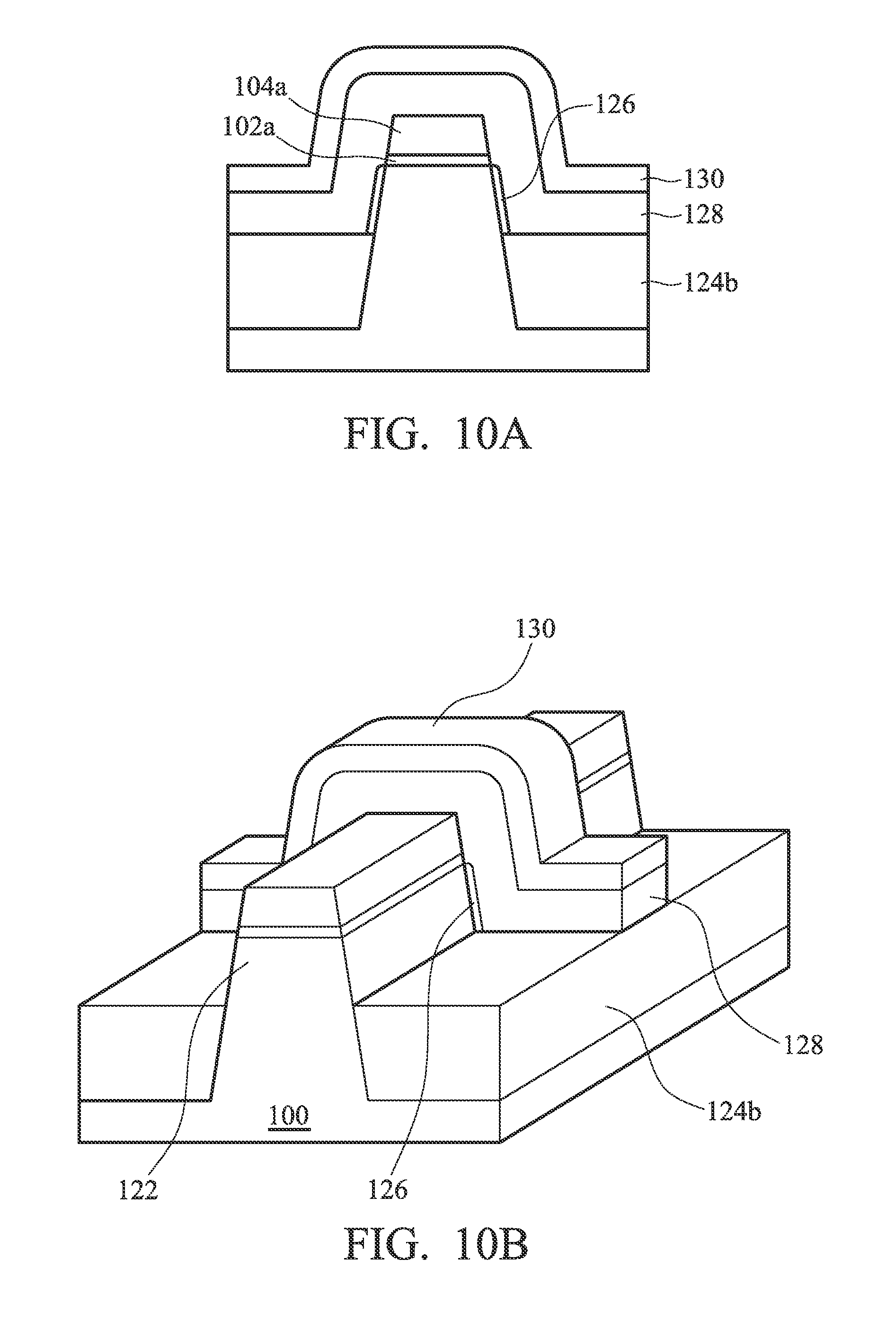
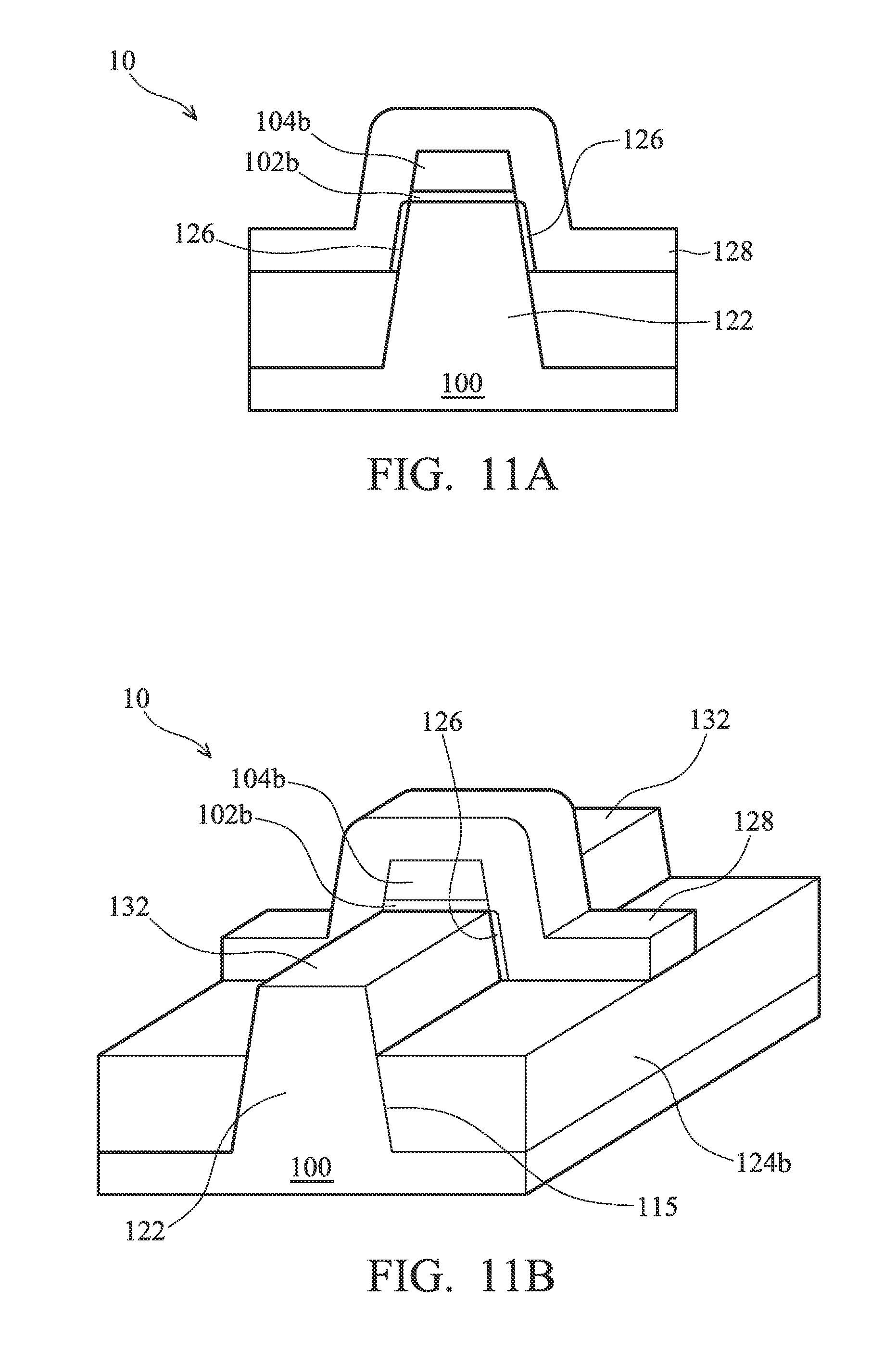
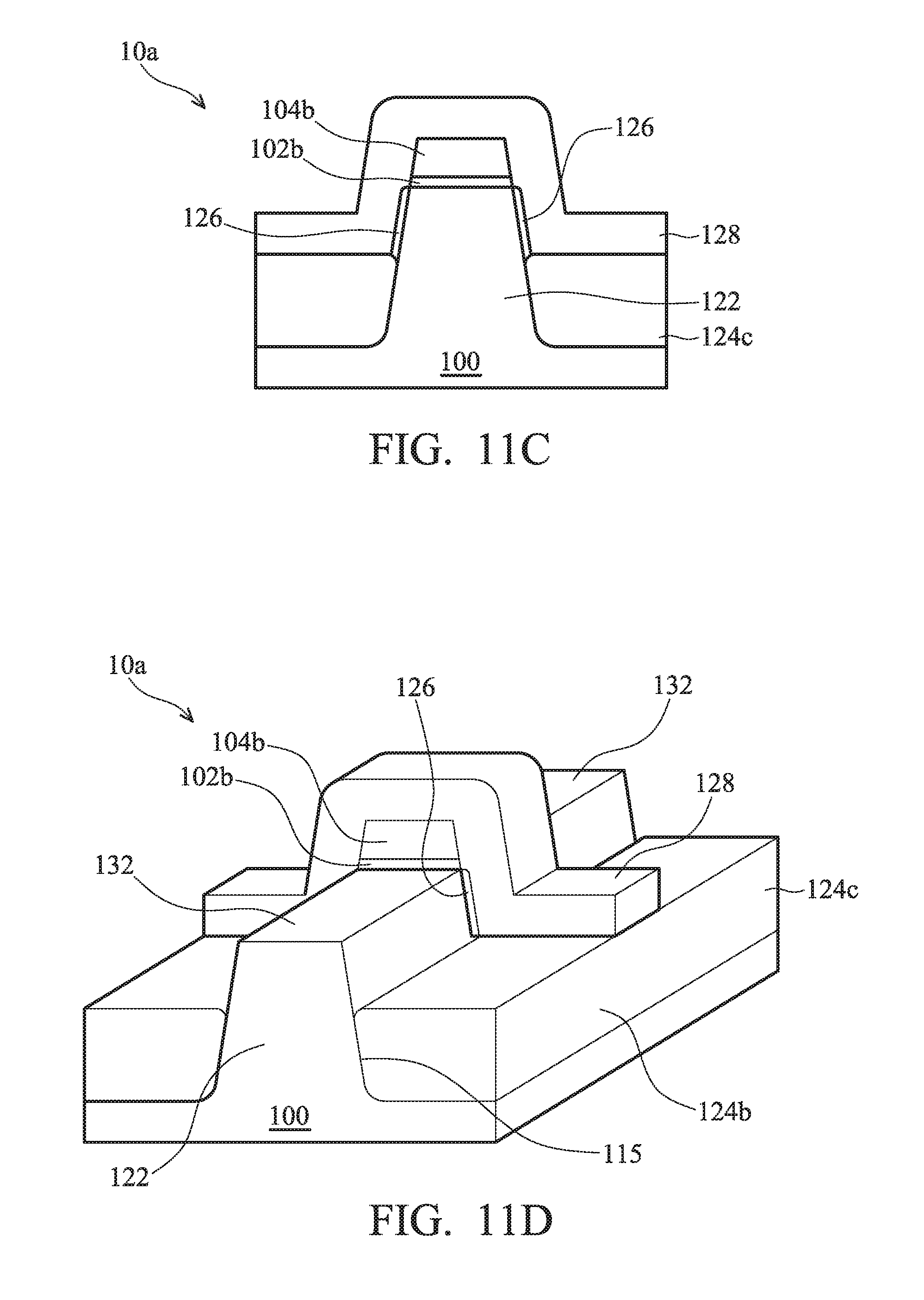
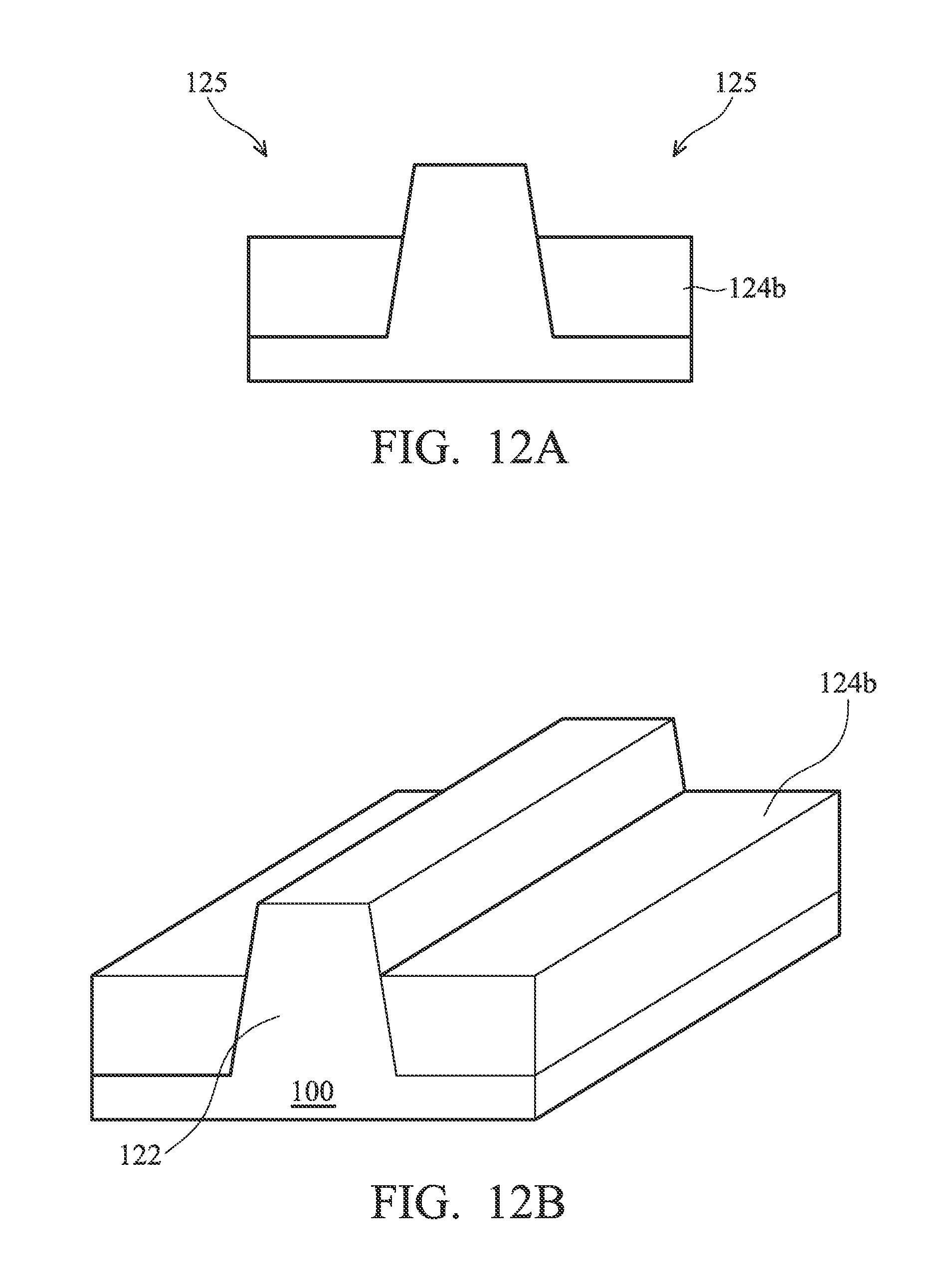
View All Diagrams
| United States Patent | 10,483,397 |
| Hsu , et al. | November 19, 2019 |
Fin field effect transistor and method of forming the same
Abstract
A fin field effect transistor and method of forming the same. The fin field effect transistor includes a semiconductor substrate having a fin structure and between two trenches with top portions and bottom portions. The fin field effect transistor further includes shallow trench isolations formed in the bottom portions of the trenches and a gate electrode over the fin structure and the shallow trench isolation, wherein the gate electrode is substantially perpendicular to the fin structure. The fin field effect transistor further includes a gate dielectric layer along sidewalls of the fin structure and source/drain electrode formed in the fin structure.
| Inventors: | Hsu; Ju-Wang (Taipei, TW), Ting; Chih-Yuan (Taipei, TW), Zhong; Tang-Xuan (Kaohsiung, TW), Su; Yi-Nien (Kaohsiung, TW), Tsai; Jang-Shiang (Zhubei, TW) | ||||||||||
|---|---|---|---|---|---|---|---|---|---|---|---|
| Applicant: |
|
||||||||||
| Assignee: | TAIWAN SEMICONDUCTOR MANUFACTURING
CO., LTD (Hsin-Chu, TW) |
||||||||||
| Family ID: | 39968750 | ||||||||||
| Appl. No.: | 14/582,576 | ||||||||||
| Filed: | December 24, 2014 |
Prior Publication Data
| Document Identifier | Publication Date | |
|---|---|---|
| US 20150137265 A1 | May 21, 2015 | |
Related U.S. Patent Documents
| Application Number | Filing Date | Patent Number | Issue Date | ||
|---|---|---|---|---|---|
| 11744896 | May 7, 2007 | 8927353 | |||
| Current U.S. Class: | 1/1 |
| Current CPC Class: | H01L 29/66795 (20130101); H01L 29/0649 (20130101); H01L 29/7851 (20130101); H01L 29/7853 (20130101) |
| Current International Class: | H01L 29/76 (20060101); H01L 29/78 (20060101); H01L 29/06 (20060101); H01L 29/66 (20060101) |
References Cited [Referenced By]
U.S. Patent Documents
| 6706571 | March 2004 | Yu et al. |
| 6812119 | November 2004 | Ahmed et al. |
| 6858478 | February 2005 | Chau et al. |
| 6885055 | April 2005 | Lee |
| 7190050 | March 2007 | King et al. |
| 7247887 | July 2007 | King et al. |
| 7265008 | September 2007 | King et al. |
| 7508031 | March 2009 | Liu et al. |
| 7528465 | May 2009 | King et al. |
| 7605449 | October 2009 | Liu et al. |
| 2005/0001252 | January 2005 | Kim |
| 2005/0035391 | February 2005 | Lee et al. |
| 2005/0133827 | June 2005 | Huang et al. |
| 2005/0145932 | July 2005 | Park et al. |
| 2005/0153490 | July 2005 | Yoon et al. |
| 2005/0170593 | August 2005 | Kang |
| 2005/0170606 | August 2005 | Fu et al. |
| 2005/0224800 | October 2005 | Lindhert et al. |
| 2006/0081895 | April 2006 | Lee |
| 2006/0275988 | December 2006 | Yagishita et al. |
| 2007/0120156 | May 2007 | Liu et al. |
| 2007/0122953 | May 2007 | Liu et al. |
| 2007/0122954 | May 2007 | Liu |
| 2007/0128782 | June 2007 | Liu et al. |
| 2007/0132053 | June 2007 | King et al. |
| 2007/0134878 | June 2007 | Brask |
| 2007/0148837 | June 2007 | Shah et al. |
| 2007/0224815 | September 2007 | Ban et al. |
| 2008/0081404 | April 2008 | Barna |
| 2008/0102570 | May 2008 | Fischer |
| 2008/0157201 | July 2008 | Marshall |
| 2008/0290470 | November 2008 | King et al. |
| 2008/0296632 | December 2008 | Moroz et al. |
| 2009/0181477 | July 2009 | King et al. |
Attorney, Agent or Firm: McClure, Qualey & Rodack, LLP
Parent Case Text
CROSS REFERENCE TO RELATED APPLICATIONS
This application is a Divisional of application Ser. No. 11/744,896, filed May 7, 2007, the entirety of which is incorporated by reference herein.
Claims
What is claimed is:
1. A fin field effect transistor, comprising: a semiconductor substrate having a fin structure between two trenches, wherein each of the two trenches has a top portion and a bottom portion, the top portion of each of the two trenches is closer to a top portion of the fin structure than the bottom portion of each of the two trenches; shallow trench isolations respectively formed in the bottom portions of the two trenches, wherein the top portion of the fin structure is tapered and above the shallow trench isolations; a gate electrode over the fin structure and the shallow trench isolations, wherein the gate electrode is perpendicular to the fin structure; a gate dielectric layer along sidewalls of the fin structure; and a source/drain doped region formed in the fin structure, wherein each of the shallow trench isolations has a rounded and convex top corner, a rounded and convex bottom corner and a straight side edge, wherein the rounded and convex top corner of each of the shallow trench isolations is close to and separated from the fin structure, wherein the rounded and convex bottom corner of each of the shallow trench isolations is in contact with the bottom portion of each of the two trenches, wherein the rounded and convex top corner of each of the shallow trench isolations is directly connected the straight side edge of each of the shallow trench isolations, and the shallow trench isolations are in contact with the fin structure, wherein the gate dielectric layer has a convex top surface and a concave bottom surface, and an entirety of the gate dielectric layer is disposed at a level between a top surface of the fin structure and the rounded and convex top corner of each of the shallow trench isolations.
2. The fin field effect transistor as claimed in claim 1, wherein the fin structure has a width of 100 .ANG. to 1000 .ANG..
3. The fin field effect transistor as claimed in claim 1, wherein the top portion of each of the two trenches has a depth of 500 .ANG. to 3000 .ANG..
4. The fin field effect transistor as claimed in claim 1, further comprising: a mask layer between the fin structure and the gate electrode, wherein the mask layer comprises silicon oxycarbide.
5. The fin field effect transistor as claimed in claim 4, wherein the gate electrode comprises ruthenium, platinum or an alloy thereof.
6. The fin field effect transistor as claimed in claim 4, wherein the gate electrode comprises molybdenum nitride, tungsten nitride, tantalum silicide, molybdenum silicide, indium oxide, tin oxide, or ruthenium oxide.
7. The fin field effect transistor as claimed in claim 6, wherein the gate dielectric layer comprises yttrium oxide.
8. The fin field effect transistor as claimed in claim 1, wherein the gate dielectric layer comprises an extending portion that extends into a space between each of the sidewalls of the fin structure and the rounded and convex top corner of each of the shallow trench isolations.
9. The fin field effect transistor as claimed in claim 8, wherein the concave bottom surface of the gate dielectric layer is in direct contact with the rounded and convex top corner of each of the shallow trench isolations.
10. The fin field effect transistor as claimed in claim 9, further comprising: a mask layer between the fin structure and the gate electrode, wherein the mask layer comprises silicon oxycarbide.
11. A fin field effect transistor, comprising: a semiconductor substrate having a fin structure between two trenches, wherein each of the two trenches has a top portion and a bottom portion, the top portion of each of the two trenches is closer to a top portion of the fin structure than the bottom portion of each of the two trenches; shallow trench isolations respectively formed in the bottom portions of the two trenches; a gate electrode over the fin structure and the shallow trench isolations, wherein a top surface of the fin structure is separated from the gate electrode by a first distance; a mask layer between the top surface of the fin structure and the gate electrode, wherein the mask layer comprises silicon oxycarbide; a gate dielectric layer along sidewalls of the fin structure, wherein the sidewalls of the fin structure are separated from the gate electrode by a second distance; and a source/drain doped region formed in the fin structure, wherein one of the shallow trench isolations is in one of the two trenches and has a rounded and convex top corner, a rounded and convex bottom corner and a straight side edge, wherein the rounded and convex top corner of the one of the shallow trench isolations is formed without extending into the fin structure, wherein the rounded and convex top corner and the rounded and convex bottom corner are connected by the straight side edge of the one of the shallow trench isolations, wherein the straight side edge of the one of the shallow trench isolations is in contact with one of the sidewalls of the fin structure, wherein the gate dielectric layer has a curved top surface and a curved bottom surface and is entirely disposed at a level between the top surface of the fin structure and the rounded and convex top corner.
12. The fin field effect transistor as claimed in claim 11, wherein the first distance is different from the second distance.
13. The fin field effect transistor as claimed in claim 11, further comprising an oxide film between the mask layer and the fin structure.
14. The fin field effect transistor as claimed in claim 11, wherein the mask layer has tapered sidewalls and a planar top surface between the tapered sidewalls, and the tapered sidewalls and the planar top surface of the mask layer are in direct contact with the gate electrode.
15. The fin field effect transistor as claimed in claim 14, wherein the gate dielectric layer comprises an extending portion that extends into a space between each of the sidewalls of the fin structure and the rounded and convex top corner.
16. The fin field effect transistor as claimed in claim 15, wherein the curved bottom surface of the gate dielectric layer is in direct contact with the rounded and convex top corner.
17. A fin field effect transistor, comprising: a semiconductor substrate having a fin structure between two trenches, wherein each of the two trenches has a top portion and a bottom portion, the top portion of each of the two trenches is closer to a top portion of the fin structure than the bottom portion of each of the two trenches; shallow trench isolations respectively formed in the bottom portions of the two trenches, wherein the top portion of the fin structure is above the shallow trench isolations, and a maximum bottom width of the top portion of the fin structure is greater than a maximum top width of the top portion of the fin structure; a gate electrode over the fin structure and the shallow trench isolations, wherein the top surface of the fin structure is separated from the gate electrode by a first oxide layer and a mask layer, and sidewalls of the fin structure are separated from the gate electrode by a second oxide layer, wherein the mask layer is made of silicon oxycarbide; and a source/drain doped region formed in the fin structure, wherein each of the shallow trench isolations has a rounded and convex bottom corner, a rounded and convex top corner, a straight side edge and a straight bottom edge, wherein the rounded and convex top corner of each of the shallow trench isolations is formed without extending into the fin structure, wherein the rounded and convex bottom corner of one of the shallow trench isolations in one of the two trenches extends between a first end and a second end, the first end is joined by the straight side edge of the one of the shallow trench isolations, and the second end is joined by the straight bottom edge of the one of the shallow trench isolations, and wherein the straight side edge and the straight bottom edge of the one of the shallow trench isolations are in contact with the bottom portion of the one of the two trenches, wherein the second oxide layer has a convex surface at a first end close to a top surface of the fin structure and a concave surface at a second end close to the rounded and convex top corner of each of the shallow trench isolations, and an entirety of the second oxide layer is disposed at a level between the top surface of the fin structure and the rounded and convex top corner of each of the shallow trench isolations.
18. The fin field effect transistor as claimed in claim 17, wherein the second oxide layer is a gate dielectric layer.
19. The fin field effect transistor as claimed in claim 17, wherein the first oxide layer is separated from the second oxide layer.
20. The fin field effect transistor as claimed in claim 17, wherein the second dielectric layer has an extending portion that extends into a space between each of the sidewalls of the fin structure and the rounded and convex top corner of each of the shallow trench isolations, and wherein the concave surface of the second dielectric layer is in direct contact with the rounded and convex top corner of each of the shallow trench isolations.
Description
BACKGROUND OF THE INVENTION
Field of the Invention
The present invention relates generally to the field of semiconductor manufacturing and, more specifically, to a fin field effect transistor and method of forming the same.
Description of the Related Art
A fin field effect transistor (FinFET) such as a double gate MOSFET structure consists of a channel formed in a vertical silicon fin. FinFETs have found wide application as electronic devices for example, in digital processing applications. FinFETs, like other transistor devices, continue to be scaled to smaller and smaller dimensions in order to improve integrated circuit performance and cost. As the FinFET device is further miniaturized, device density will increase. It also becomes increasingly technically challenging to fabricate the FinFET features in the needed smaller dimensions.
The needed width of the fin structure is beyond the resolution limit or capabilities using the lithographic techniques currently available. Thus, fabrication methods different from the standard lithographic technique must be utilized. These techniques, which generally involve forming a larger silicon structure than desired for the final size, and then trimming the structure dimension through various means to the desired measure, have drawbacks that render them unacceptable. One such method of trimming oversize silicon fins involves an RIE (reactive ion etch) technique to trim down the silicon fin from its originally overdefined size. Thus, the technique is not viable for technology nodes going below that dimension. RIE is also an undesirable technique in that it generates fin structures with surface roughness. Surface roughness leads to poor electrical performance in the finished transistor.
U.S. Pat. No. 6,812,119 to Ahmed et al. discloses narrow fins by oxidation in double-gate FinFETs. The method of forming fins for a double-gate fin field effect transistor (FinFET) includes forming a second layer of semi-conducting material over a first layer of semi-conducting material and forming double caps in the second layer of semi-conducting material. The method further includes forming spacers adjacent sides of each of the double caps and forming double fins in the first layer of semi-conducting material beneath the double caps. The method also includes thinning the double fins to produce narrow double fins.
There are, however, still some problems regarding overdefined size or surface roughness.
BRIEF SUMMARY OF THE INVENTION
Therefore, there is a need to develop an improved fin field effect transistor and method of forming the same to prevent the above mentioned problems such as poor electrical performance resulting from surface roughness or high process complexity resulting from shrinking the overdefined size feature.
It is therefore an object of the invention to provide fin field effect transistors and methods of forming the same that can further improve electrical performance.
Another object of the invention is to reduce the process complexity of the fin field effect transistor.
Yet another object of the invention is to improve the manufacturing integration of the fin field effect transistor.
A fin field effect transistor and method of forming the same are provided. An embodiment of a fin field effect transistor comprises a semiconductor substrate having a fin structure and between two trenches with top portions and bottom portions. The fin field effect transistor further comprises shallow trench isolations formed in the bottom portions of the trenches and a gate electrode over the fin structure and the shallow trench isolation, wherein the gate electrode is substantially perpendicular to the fin structure. The fin field effect transistor further comprises a gate dielectric layer along sidewalls of the fin structure and source/drain electrode formed in the fin structure.
Another embodiment of a fin field effect transistor comprises a semiconductor substrate having a fin structure between two trenches with top portions and bottom portions. The fin field effect transistor further comprises shallow trench isolations formed in the bottom portions of the trenches. The fin field effect transistor further comprises a gate electrode over the fin structure and the shallow trench isolation. A top surface of the fin structure is separated from the gate electrode by a first distance. The fin field effect transistor further comprises a gate dielectric layer along sidewalls of the fin structure. Sidewalls of the fin structure are separated from the gate electrode by a second distance. The fin field effect transistor further comprises a source/drain electrode formed in the fin structure.
Yet another embodiment of a fin field effect transistor comprises a semiconductor substrate having a fin structure between two trenches with top portions and bottom portions. The fin field effect transistor further comprises shallow trench isolations formed in the bottom portions of the trenches. The fin field effect transistor further comprises a gate electrode over the fin structure and the shallow trench isolation. A top surface of the fin structure is separated from the gate electrode by a first oxide layer, and sidewalls of the fin structure are separated from the gate electrode by a second oxide layer. The fin field effect transistor further comprises a source/drain electrode formed in the fin structure.
An embodiment of a method of forming a fin field effect transistor is provided. First, a semiconductor substrate is provided. A first masking layer is formed overlying the semiconductor substrate. A second masking layer is formed overlying the first masking layer. A photoresist pattern with a first width is formed overlying the second masking layer. The second masking layer is etched while using the photoresist pattern as an etch mask. The photoresist pattern is trimmed to form a trimmed photoresist pattern with a second width smaller than the first width. The second masking layer and the first masking layer are etched while using the trimmed photoresist pattern as an etch mask to form a stacked mask comprising the first masking layer and the second masking layer. The semiconductor substrate is etched to form a fin structure between two trenches.
A detailed description is given in the following embodiments with reference to the accompanying drawings.
BRIEF DESCRIPTION OF THE DRAWINGS
The present invention can be more fully understood by reading the subsequent detailed description and examples with references made to the accompanying drawings, wherein:
FIGS. 1-5, 6A, 6B, 7, 8, 9A, 9B, 10A, 10B, 11A and 11B are cross sections or perspective views showing an embodiment of the formation of a fin field effect transistor, and FIG. 9C and FIG. 9D are cross sections or perspective views showing an embodiment of the formation of a fin field effect transistor after performing the stage shown in FIGS. 9A and 9B.
FIGS. 11C, 11D, 12A, 12B, 13A and 13B are cross sections or perspective views showing another embodiment of the formation of a fin field effect transistor.
DETAILED DESCRIPTION OF THE INVENTION
The following description is of the best-contemplated mode of carrying out the invention. This description is made for the purpose of illustrating the general principles of the invention and should not be taken in a limiting sense. The scope of the invention is best determined by reference to the appended claims.
As shown in FIG. 1, a semiconductor substrate 100 such as a silicon substrate or a silicon/Germanium substrate is provided. A first oxide film 102 such as silicon oxide having a thickness of about 50 .ANG. to 100 .ANG. is optionally formed on the semiconductor substrate 100 by thermal oxidation. The first oxide film 102 may enhance adhesion between the semiconductor substrate 100 and first masking layer 104 formed in the following step.
A first masking layer 104 such as silicon nitride (Si.sub.3N.sub.4) is formed on the first oxide film 102 by chemical vapor deposition such as plasma enhanced chemical vapor deposition (PECVD), low pressure chemical vapor deposition (LPCVD) using dichlorosilane (SiH.sub.2Cl.sub.2) and ammonia (NH.sub.3). Alternately, silicon nitride can be replaced by titanium nitride, silicon carbide or silicon oxycarbide. The first masking layer 104 has a thickness of about 300 .ANG. to 500 .ANG., preferably about 400 .ANG..
A second oxide film 106 such as silicon oxide having a thickness of about 50 to 100 .ANG. is optionally formed on the first masking layer 104 by plasma enhanced chemical vapor deposition (PECVD). The second oxide film 106 may enhance adhesion of the first masking layer 104 and the second masking layer 108 formed in the following step.
A second masking layer 108 such as silicon oxynitride (SiON) is formed on the second oxide film 106 by chemical vapor deposition (CVD) such as plasma enhanced chemical vapor deposition (PECVD), low pressure chemical vapor deposition (LPCVD) using silane (SiH.sub.4), ammonia (NH.sub.3) and nitrous nitride (NO.sub.2). Alternately, silicon oxynitride can be replaced by titanium nitride, silicon carbide or silicon oxycarbide. The second masking layer 108 has a thickness of about 400 .ANG. to 600 .ANG., preferably about 500 .ANG.. The second masking layer 108 preferably comprises a different material from that of the first masking layer 104.
Referring to FIG. 2 and FIG. 3, to enhance control of critical dimension (CD) by suppressing standing wave effects and reflective notching caused by thin film interference, a bottom anti-reflective coating 110 is optionally formed on the second masking layer 108. The bottom anti-reflective coating 110 has a thickness of about 200 .ANG. to 1500 .ANG.. The bottom anti-reflective coating 110 can comprise a carbon-based organic material or inorganic material such as silicon oxime, silicon oxynitride, or silicon nitride. Alternately, an additional silicon oxide layer (not shown) may be further formed on the second masking layer 108 before forming the bottom anti-reflective coating 110. A photoresist pattern 112 having a first width W1 (500 .ANG. to 3000 .ANG.) is formed on the bottom anti-reflective coating 110 and over the second masking layer 108 by photolithography consisting of photoresist spin coating, soft baking, exposing, developing, and hard baking.
The bottom anti-reflective coating 110 and the second masking layer 108 are etched while using the photoresist pattern 112 as an etch mask to leave a bottom anti-reflective coating 110a and a second masking layer 108a until the second oxide film 106 is exposed. That is, second oxide film 106 serves as the etch stop layer during the etching process of the bottom anti-reflective coating 110 and the second masking layer 108. Next, referring to FIG. 4, photoresist pattern 112 is trimmed by laser trimming, etch trimming, thermal trimming or wet chemical immersion to form a trimmed photoresist pattern 112a with a second width W2 smaller than the first width W1, the thickness of the trimmed photoresist pattern 112a may also smaller than that of the photoresist pattern 112. The second width W2 is about 100 .ANG. to 2000 .ANG., preferably 300 .ANG. to 1000 .ANG.. The bottom anti-reflective coating 110a, second masking layer 108a, the second oxide film 106, first masking layer 104, and the first oxide film 102 are etched while the trimmed photoresist pattern 112a is used as a etch mask so as to leave a stacked mask 120 including second masking layer 108b, second oxide film 106a, first masking layer 104a and first oxide film 102a.
The exemplary process of etching the second masking layer 108 as shown in FIG. 3 followed by trimming the photoresist pattern 112 as shown in FIG. 4 is described above. Alternately, the second masking layer 108, the second oxide film 106, the first masking layer 104 and the first oxide film 102 are etched after the trimmed photoresist pattern 112a is formed.
As shown in FIG. 4 and FIG. 5, the trimmed photoresist pattern 112a and the bottom anti-reflective coating 110b are removed by etching or ashing containing oxygen plasma until semiconductor substrate 100 is exposed. Then, the semiconductor substrate 100 is etched by a transformer coupled plasma (TCP) etcher, or a capacitive coupling plasma (CCP) etcher, a microwave down stream etcher using Cl.sub.2, HBr, and/or SF.sub.6 to leave a fin structure 122 between trenches 115 as shown in FIG. 6a and FIG. 6b. The fin structure 122 has a desirable width or dimension because the pattern of the stacked mask 120 having a width similar to the width W2 of the trimmed photoresist pattern 112a. Therefore, the fin field effect transistor has a narrower dimension without trimming the fin structure 122 down from its originally overdefined size. Thus, the process complexity of the fin field effect transistor can be simplified. Furthermore, over-etching of the fin structure may be prevented. Also, the electrical performance resulting from surface roughness may be prevented.
The fin structure 122 is tapered toward the stacked mask 120. Preferably, the included angle .theta. of the upper surface and the sidewall of the fin structure 122 is about 83.degree. to 89.degree..
As shown in FIG. 7, an isolation layer 124, for example silicon oxide, is deposited over the semiconductor substrate 100 and the stacked mask 120 filling in the trenches 115 by high density plasma chemical vapor deposition (HDPCVD) using SiH.sub.4 and N.sub.2O.
Referring now to FIG. 8, the isolation layer 124 is planarized by chemical mechanical polishing (CMP) while the stacked mask 120 is used as a polish stop layer to leave an intermediate isolation layer 124a. Next, as shown in FIG. 9A and FIG. 9B, the intermediate isolation layer 124a is recessed or partially removed to form shallow trench isolations 124b and recesses 125 above the shallow trench isolations 124b so that the top portion of fin structure 122 is exposed. The recesses 125 may have depths of about 500 .ANG. to 3000 .ANG.. The second masking layer 108b and the second oxide film 106a are then removed by dry or wet etching. Optionally, as shown in FIG. 9C and FIG. 9D, the semiconductor substrate 100 with shallow trench isolation 124b is subjected annealing at a high temperature of about 700.degree. C.-1000.degree. C. so that the shallow trench isolation 124c has a rounded top corner and/or a rounded bottom corner. Alternately, a part of the stacked mask 120 may be removed in the step of chemical mechanical polishing of isolation layer 124. That is, the second masking layer 108b and the second oxide film 106a are simultaneously polished away while the first masking layer 104a is used as the polish stop layer.
Next, as shown in FIG. 10A and FIG. 10B, a gate dielectric layer 126 such as silicon oxide is formed along the sidewalls of top portion the fin structure 122 by thermal oxidation. Alternately, the gate dielectric layer 126 may comprise aluminum oxide, lanthanum aluminum oxide, hafnium oxynitride, silicon oxynitride, zirconium oxide, hafnium oxide, lanthanum oxide, yttrium oxide or silicon oxide. The gate dielectric layer 126 may be formed by chemical vapor deposition and may be a single layer, a double layer or a composite layer. The gate dielectric layer 126 may have a thickness of about 50 .ANG. to 200 .ANG., preferably 50 .ANG. to 100 .ANG..
Then, a conductive layer such as a metal layer is deposited by physical vapor deposition, such as sputtering using a metal target. A hard mask 130 comprising a different material from the first masking layer 104a is formed on the conductive layer by a masking layer deposition, photolithography and etching. In one embodiment of the invention, hard mask 130 may comprise silicon oxynitride. The hard mask 130 is substantially perpendicular to the fin structure 122. The conductive layer is etched while the hard mask 130 is used as an etch stop layer to form a gate electrode 128. The gate electrode 128 may comprise titanium, tantalum, molybdenum, ruthenium, tungsten or platinum or an alloy thereof or titanium nitride, tantalum nitride, molybdenum nitride, tungsten nitride, titanium silicide, tantalum silicide, molybdenum silicide, tungsten silicide, indium oxide, tin oxide, or ruthenium oxide.
Referring to FIG. 11A and FIG. 11B, the first masking layer 104b and the first oxide film 102a are removed until the upper surface of the fin structure 122 is exposed while the hard mask 130 is used as an etch stop layer to leave a first masking layer 104b and a first oxide film 102b under the gate electrode 128. Next, the hard mask 130 is removed by reactive ion etching or wet etching. Ions or impurities are implanted in the top portion of the fin structure 122 to form a source/drain doped region 132 from the upper surface thereof thus a fin field effect transistor 10 is generated. Optionally, as shown in FIG. 11C and FIG. 11D, a fin field effect transistor 10a is similar to the fin field effect transistor 10 except that the fin field effect transistor 10a includes a shallow trench isolation 124c having a rounded top corner and/or a rounded bottom corner formed by the processes related to FIG. 9C and FIG. 9D.
The fin field effect transistor 10 comprises a semiconductor substrate 100 having a fin structure 122 between two trenches 115 with top portions and bottom portions and shallow trench isolations 124b formed in the bottom portions of the trenches 115. The fin field effect transistor 10 further comprises a gate electrode 128 over the fin structure 122 and the shallow trench isolation 124b, wherein the gate electrode 128 is substantially perpendicular to the fin structure 122. The fin field effect transistor 10 further comprises a gate dielectric layer 126 along sidewalls of the top portion of the fin structure 122 and source/drain doped region 132, source/drain electrode, formed in the top portion of the fin structure 122. The fin field effect transistor 10 may comprise a mask layer consisting of first masking layer 104b and first oxide film 102b between the fin structure 122 and the gate electrode 128. Because a part of the stacked mask 120 is removed before recessing the isolation layer 124, the mask layer has a relatively smaller thickness as compared to that of the prior art thus topography may be reduced. The fin structure 122 may have a thickness of about 100 .ANG. to 1000 .ANG.. The top portions of the trenches 115 may have a depth of about 500 .ANG. to 3000 .ANG.. The fin structure 122 is tapered toward the top portion thereof. Preferably, the included angle of the upper surface and the sidewall of the fin structure 122 is about 83.degree. to 89.degree..
FIGS. 12A, 12B, 13A and 13B are cross sections or perspective views showing another embodiment of the formation of a fin field effect transistor. The exemplary process as shown in FIGS. 12a to 13b is substantially similar to that as shown in FIGS. 9a to 11b except that the first oxide film 102a and first masking layer 104a are removed to expose the top surface of the fin structure 122 before forming the gate dielectric layer 126. Thus, the gate dielectric layer 126 is formed along the sidewalls and the top surface of the fin structure 122.
According to the exemplary processes of the fin field effect transistor mentioned above, the first masking layer 104 used for the shallow trench isolation polish stop layer and the second oxide film 106 for transferring the trimmed photoresist pattern are different materials, thus manufacturing integration can be improved.
While the invention has been described by way of example and in terms of the preferred embodiments, it is to be understood that the invention is not limited to the disclosed embodiments. To the contrary, it is intended to cover various modifications and similar arrangements (as would be apparent to those skilled in the art). Therefore, the scope of the appended claims should be accorded the broadest interpretation so as to encompass all such modifications and similar arrangements.
* * * * *
D00000

D00001

D00002

D00003

D00004

D00005

D00006

D00007

D00008

D00009

D00010

D00011

D00012
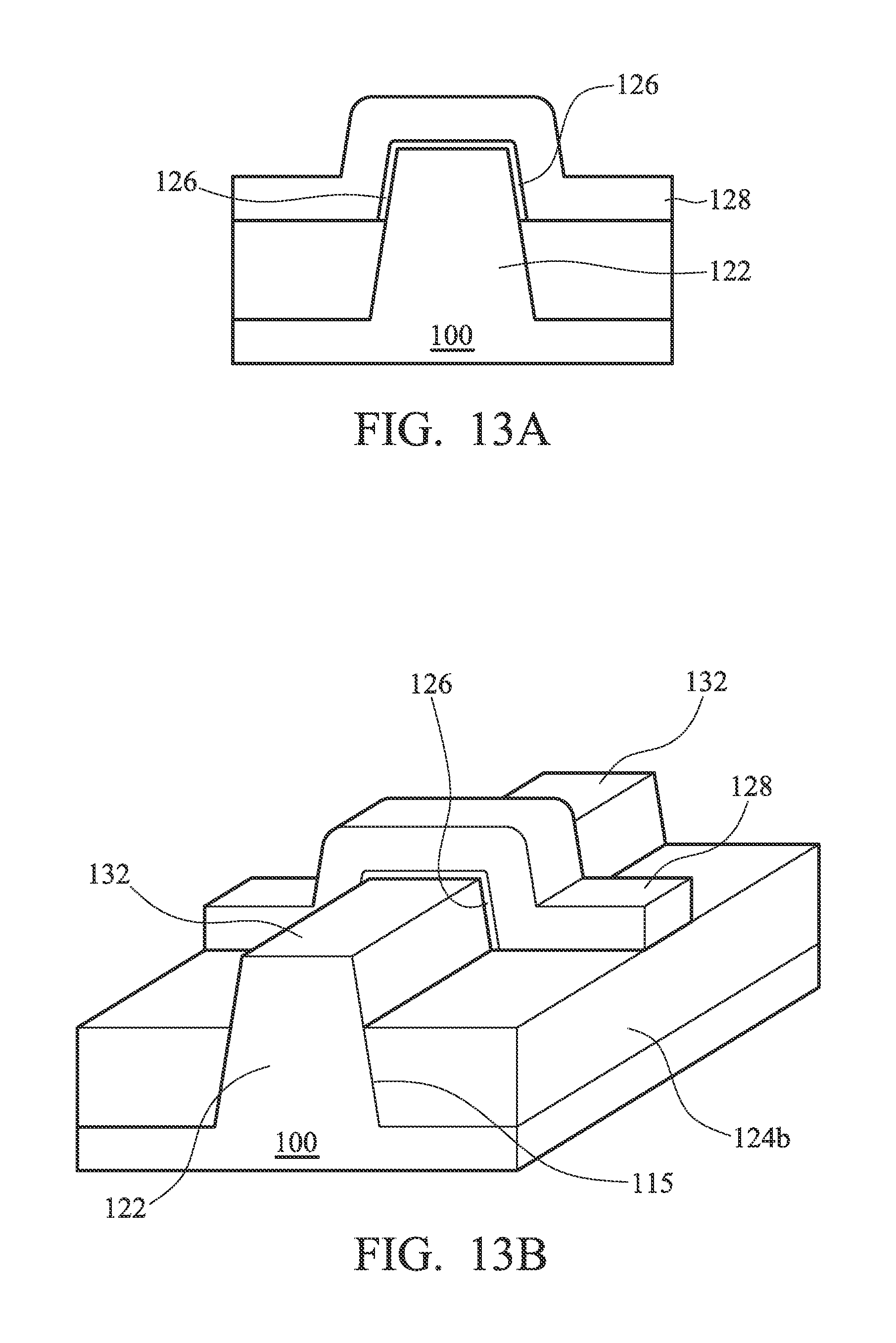
XML
uspto.report is an independent third-party trademark research tool that is not affiliated, endorsed, or sponsored by the United States Patent and Trademark Office (USPTO) or any other governmental organization. The information provided by uspto.report is based on publicly available data at the time of writing and is intended for informational purposes only.
While we strive to provide accurate and up-to-date information, we do not guarantee the accuracy, completeness, reliability, or suitability of the information displayed on this site. The use of this site is at your own risk. Any reliance you place on such information is therefore strictly at your own risk.
All official trademark data, including owner information, should be verified by visiting the official USPTO website at www.uspto.gov. This site is not intended to replace professional legal advice and should not be used as a substitute for consulting with a legal professional who is knowledgeable about trademark law.